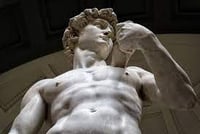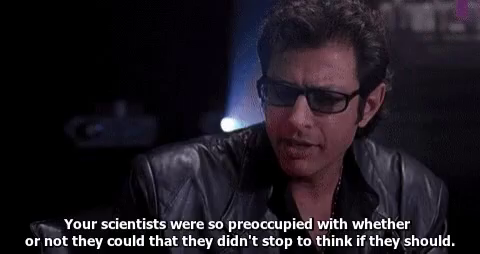 My wife put her studies on hold while I completed my PhD in cancer biology to take care of our son, but is now on the verge of getting her art history degree! One of her current classes is discussing the role of technology in art, and she stumbled across this older article that addresses the field of "bio-art," or art that represents a crossover between art and the biological sciences. I never really considered this as a contemporary art form, but I guess, separate from the illustrators or photographers who produce content for textbooks and science magazines, as well as the graphic designers who make the signal transduction diagrams and informational graphics for our references, bioscience has advanced to a point where we can manipulate cells in culture and living organisms to produce works of art that could be easily recognizable or more abstract. Since we are talking about living tissues being employed in the display of art, there are ethical considerations in play that we will explore in this article.
My wife put her studies on hold while I completed my PhD in cancer biology to take care of our son, but is now on the verge of getting her art history degree! One of her current classes is discussing the role of technology in art, and she stumbled across this older article that addresses the field of "bio-art," or art that represents a crossover between art and the biological sciences. I never really considered this as a contemporary art form, but I guess, separate from the illustrators or photographers who produce content for textbooks and science magazines, as well as the graphic designers who make the signal transduction diagrams and informational graphics for our references, bioscience has advanced to a point where we can manipulate cells in culture and living organisms to produce works of art that could be easily recognizable or more abstract. Since we are talking about living tissues being employed in the display of art, there are ethical considerations in play that we will explore in this article.
What is Bio-Art?
Bio-Art, bioart, or BioArt, depending on who writes it, is a bridge between art and science, where biology is "hacked" to produce an art work. The way it is described makes it potentially more invasive than a tattoo, as it may involve medicines, genetic alteration, or surgical manipulation of the body. Instead of a canvas or an uncut slab of marble, the new "canvas" is genetic material like DNA, cells, and even living animals including the artist themselves. The philosophy behind the Bio-Art movement is to encourage discussion on the relationships between living organisms and inanimate objects.
 Because of the need to manipulate biomolecules, living tissues, or even animals to produce their artwork, Bio-Art practitioners have to find a willing partner in laboratory science who is adept at performing the necessary modifications. Accordingly, at least as of 2014 when this editorial was posted, many scientific institutions are welcoming of artists because they want to contribute to the art world as well as to use the art as a platform for scientific awareness. There are also some motivations for the scientist to hone their experimental skills, as in the example of the modified butterfly wing patterning, which was performed for artist Marta de Menezes by an evolutionary biologist, who no doubt had some interest in learning more about the process while creating this Bio-Art.
Because of the need to manipulate biomolecules, living tissues, or even animals to produce their artwork, Bio-Art practitioners have to find a willing partner in laboratory science who is adept at performing the necessary modifications. Accordingly, at least as of 2014 when this editorial was posted, many scientific institutions are welcoming of artists because they want to contribute to the art world as well as to use the art as a platform for scientific awareness. There are also some motivations for the scientist to hone their experimental skills, as in the example of the modified butterfly wing patterning, which was performed for artist Marta de Menezes by an evolutionary biologist, who no doubt had some interest in learning more about the process while creating this Bio-Art.
Examples of Bio-Art
 One could argue that "Bio-Art" began at least as early as the Renaissance, when noted Teenage Mutant Ninja Turtles Leonardo da Vinci and Michelangelo employed extensive studies of human anatomy to produce life-like art that has stood the test of time. As the Bio-Art movement continues to grow, there are some prominent artists that we might have happened across in mainstream news, including the famous (or infamous?) Eduardo Kac, who kickstarted the field with his presentation of Alba, the GFP bunny. At least according to Kac, Alba is not just a novelty, but a complex exercise in helping open up multidisciplinary dialogue while pushing the envelope for what is possible with genetics and science.
One could argue that "Bio-Art" began at least as early as the Renaissance, when noted Teenage Mutant Ninja Turtles Leonardo da Vinci and Michelangelo employed extensive studies of human anatomy to produce life-like art that has stood the test of time. As the Bio-Art movement continues to grow, there are some prominent artists that we might have happened across in mainstream news, including the famous (or infamous?) Eduardo Kac, who kickstarted the field with his presentation of Alba, the GFP bunny. At least according to Kac, Alba is not just a novelty, but a complex exercise in helping open up multidisciplinary dialogue while pushing the envelope for what is possible with genetics and science.
Plants have always been used as a form of art, with botanists and horticulturalists creating lush gardens and landscapes to beautiful the community surrounding urbanized areas as an example, not to mention all the flowers and associated flora that give their lives every birthday, anniversary, and Valentine's Day. British artists Heather Ackroyd and Dan Harvey took their plant-based art to another level, using living grass as a canvas and the chlorophyll within that grass as their pigment. By modulating the amount of light that shines on each section of grass, they can control the abundance and brightness of the chlorophyll in that section to create what seems like a tinted photograph. Because the grass will eventually die, they will also naturally fade like a real photograph.
A sampling of the prominent Bio-Artists and their works can be found here.
Bio-Art and Bioethics
As with anything involving living things, including animals, there are ethical considerations that need to be addressed to ensure the "canvas" does not suffer unnecessary harm. In the case of the modified butterfly, I do not believe there were any studies to determine whether the wing pattern changes would affect their livelihood, and although a pigment change might not seem too significant, science is not based on untested assumptions. There is also the strange case of the artist Stelarc embedding an ear into his arm, which evokes the Jeff Goldblum quote from Jurassic Park for me. While it is true that Bio-Art can use their own bodies in their work (and that is implied consent), it seems a bit more extreme than folks who have extensive tattoo and piercing work; I can't really articulate why, I guess it's just really weird! And because we know people are impressionable, it may motivate some to emulate the work, in a way that is possibly more unsafe than when Stelarc finally found a surgeon to do it for him.

The use of genetic manipulation to produce Bio-Art is also quite controversial, similarly to the movements against genetically modified crops and livestock to support our food supply. Without proper regulation, in addition to not supervising the welfare of animal "canvases," the introduction of harmful effects of unsafe procedures could pose a biosafety threat. On the other hand, Bio-Art argues that it pushes the envelope to engage with this interface between science and creativity, to enjoy the emotions elicited by viewing this crossover artwork. The one major issue I can think of is how prominent artists of the classical era could affect the public's perception of beauty; adding a biological and genetic component to the proverbial artist's brush could be one step away from eugenics in a GATTACA-like scenario, where the rapidly improving technologies could allow someone to alter themselves not for health reasons, but for vanity.
Pushing the Envelope
Bio-Art is not going away anytime soon, and the artists push back on the argument that the use of technology in art will have a negative impact on society, not to mention our appreciation of "true" art. Bio-Artists will say that they manipulate natural canvases in a way that inspires thought, and if you're considering the ramifications of Bio-Art as I have, then they have succeeded. With more education and perhaps a bit more regulation, there is a place for Bio-Art in our lives to provoke that deeper thought.



